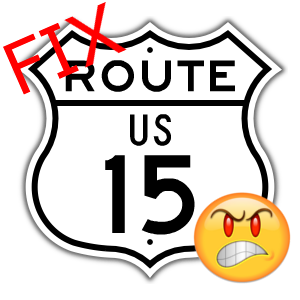Day 4: We need a 30-year solution!
One key point that we at fixroute15now.com advocate is that the corridor needs a long-term solution. Given that many projects in the region are competing for the same project dollars, we must not waste our time and money on feel-good “solutions” that will not serve through this time period. We WON’T get a do-over. Since it will take the county at least 10 years to widen a 3.5 mile section of the Route 15 corridor, we must look at growth curves going out 40 years.The lower corridor today handles 26,000 vehicles per day (vpd). Kimley-Horn’s US Route 15 Congestion Report, dated May 18,2017, uses a 1.5% forecasted growth rate for the lower-end of the corridor (Battlefield Parkway to Montresor Road). See Section 6: Traffic Forecasts (pages 25-26) of the report: https://lfportal.loudoun.gov/LFPortalinternet/0/doc/218963/Electronic.aspxThis is a conservative estimate considering volumes have been increasing by 3% per year for the last 5 years and spiked at 10% growth during 2017 – the last year for which records are available. We’ll say for the sake of argument that actual annual growth for the next 40 years will average somewhere between those two numbers. The chart below shows what that volume increase for the Lower Corridor will look like at different rates of growth: What this chart tells us is that at even the most conservative growth rate estimate, 47,000 vehicles (predominately North-South traffic) will travel the Route 15 Lower Corridor on a daily basis at the end of the project’s lifespan (Phase I).As for the Northern half of the corridor, Kimley-Horn will publish their projections in the next Safety & Operations Study, anticipated to be released in September. While we’re waiting for them, let’s use the same rates of growth from the first chart on the current volume of 21,000 vpd at the Point Of Rocks Bridge: Keep in mind the following previously established maximum capacities:Single lane roundabouts – 25,000 vehicles per dayMulti-lane roundabouts – 45,000 vehicles per day2-lane road – 18,000 vehicles per day4-lane road – 37,000 vehicles per day From this information, we can reasonably conclude several things:Single-lane roundabouts will fail the Lower Corridor NOW even under CURRENT volumes.Single-lane roundabouts will fail the Northern Corridor by the time they are completed.Multi-lane roundabouts will fail the Lower Corridor within the project lifespan.Multi-lane roundabouts will fail the Northern Corridor within the project lifespan under all but the most conservative growth estimates.The entire corridor will fail without widening to 4-lanes and the Lower Corridor could eventually need more than that. Let’s hope that by 2057 there is a new Potomac crossing bridge in the works to take the stress off of Route 15.These facts and capacities are NOT in dispute. Even one of the special interest groups’ website acknowledges the ~25,000 vpd capacity of single lane roundabouts: https://web.archive.org/web/20050207120921/http://catoctincoalition.com:80/FAQs.htmlYet, they still advocate for such a solution for the corridor even though they know it will fail. Why? Well, the main point of argument that they make is that widening the road will mean that more vehicles will use it,…
